engine CHEVROLET ASTRO 1998 2.G Manual PDF
[x] Cancel search | Manufacturer: CHEVROLET, Model Year: 1998, Model line: ASTRO, Model: CHEVROLET ASTRO 1998 2.GPages: 414, PDF Size: 21.46 MB
Page 71 of 414
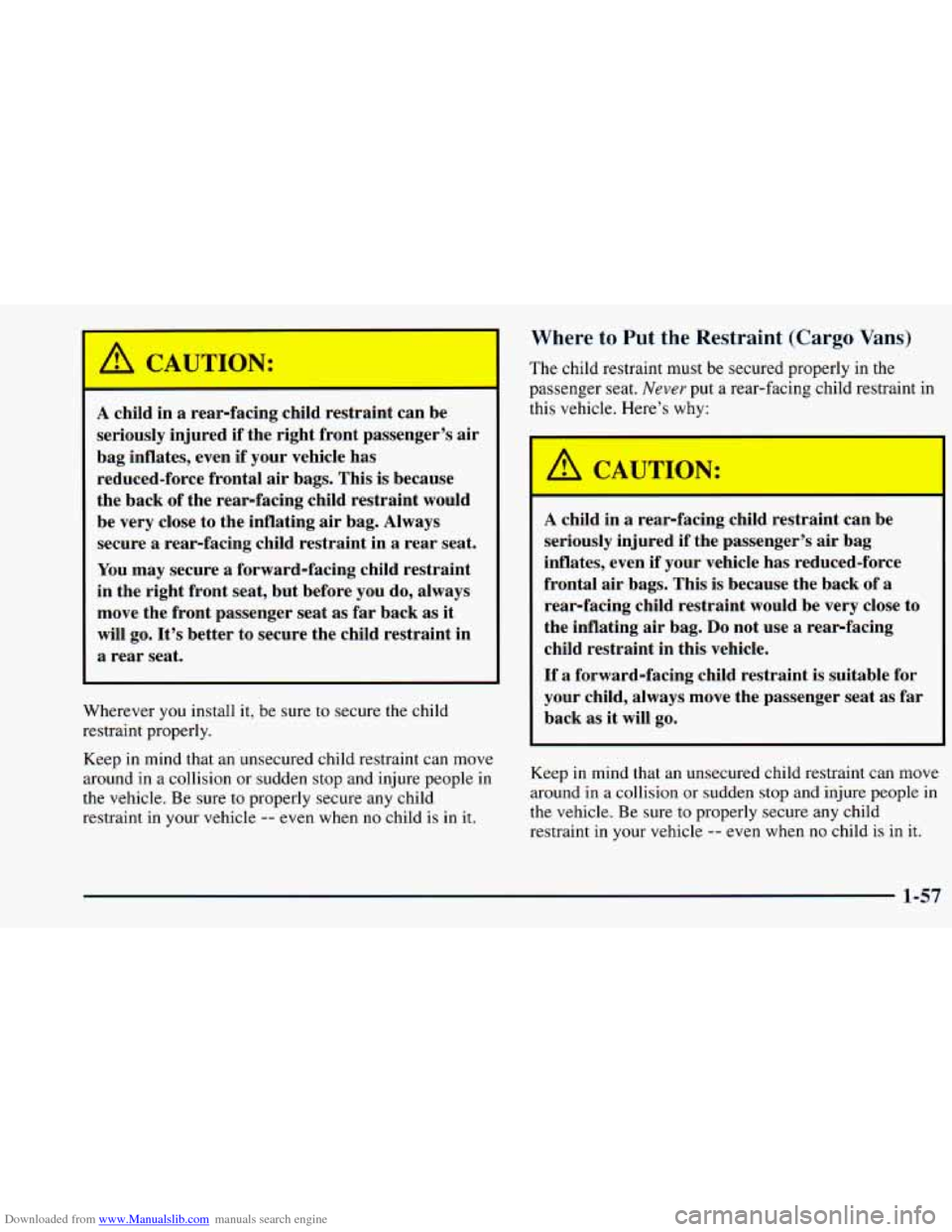
Downloaded from www.Manualslib.com manuals search engine /1 CAUTION:
A child in a rear-facing child restraint can be
seriously injured if the right front passenger’s air
bag inflates, even if your vehicle has
reduced-force frontal air bags. This is because
the back of the rear-facing child restraint would
be very close to the inflating air bag. Always
secure a rear-facing child restraint in
a rear seat.
You may secure a forward-facing child restraint
in the right front seat, but before you do, always
move the front passenger seat as far back as it
will go.
It’s better to secure the child restraint in
a rear seat.
Wherever you install it, be sure to secure the child
restraint properly.
Keep in mind that an unsecured child restraint can move
around in a collision or sudden stop and injure people in
the vehicle. Be sure to properly secure any child
restraint in your vehicle
-- even when no child is in it.
Where to Put the Restraint (Cargo Vans)
The child restraint must be secured properly in the
passenger seat.
Never put a rear-facing child restraint in
this vehicle. Here’s why:
A child in a rear-facing child restraint can be
seriously injured
if the passenger’s air bag
inflates, even
if your vehicle has reduced-force
frontal air bags. This is because the back of a
rear-facing child restraint would be very close to
the inflating air bag.
Do not use a rear-facing
child restraint in this vehicle.
If a forward-facing child restraint is suitable for
your child, always move the passenger seat as
far
back as it will go.
Keep in mind that an unsecured child restraint can move
around in a collision or sudden stop and injure people in
the vehicle. Be sure
to properly secure any child
restraint in your vehicle
-- even when no child is in it.
1-57
Page 72 of 414
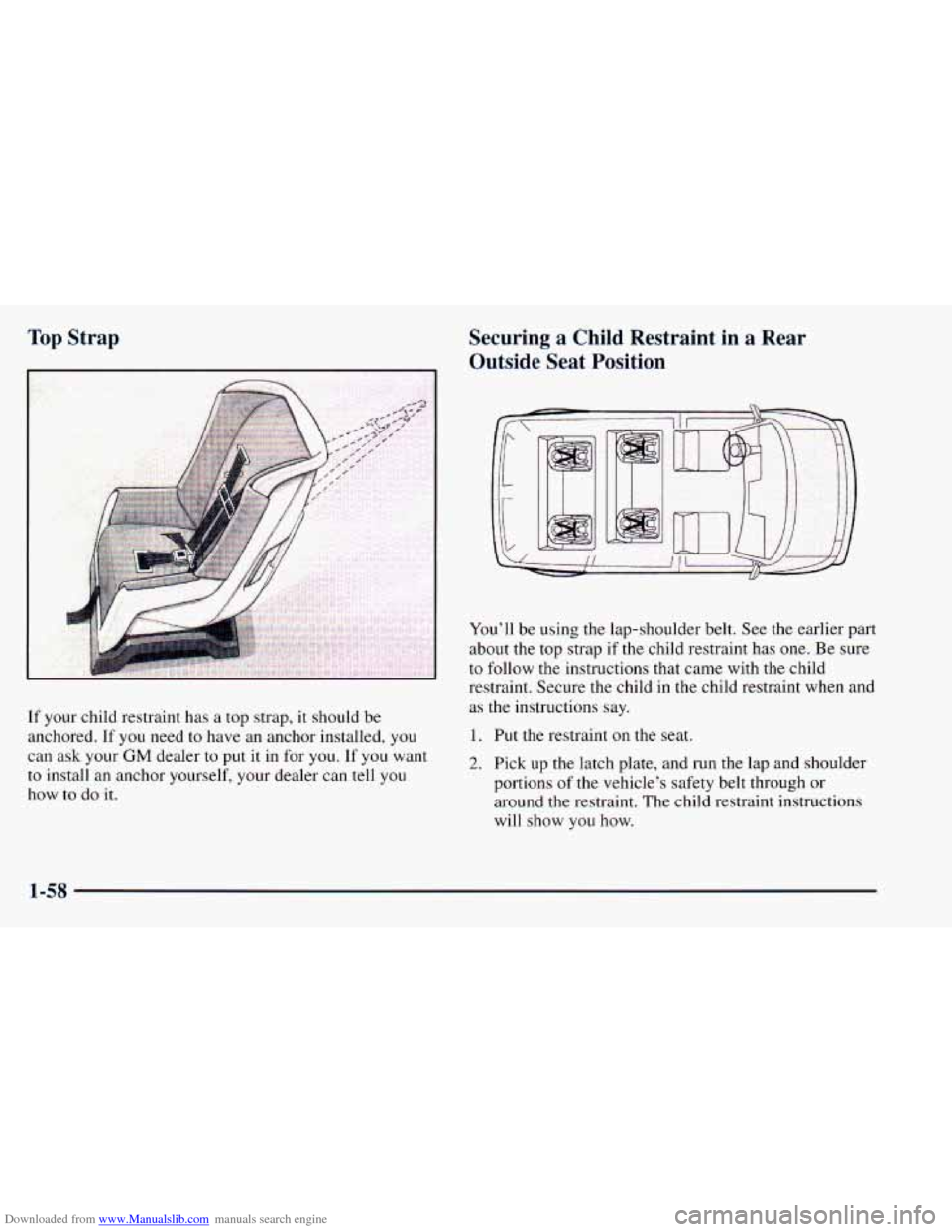
Downloaded from www.Manualslib.com manuals search engine Top Strap Securing a Child Restraint in a Rear
i Outside Seat Position
If your child restraint has a top strap, it should be
anchored.
If you need to have an anchor installed, you
can ask your GM dealer to put it in for you. If you want
to install an anchor yourself, your dealer can tell you
how to do it.
as the instructions say.
1. Put the restraint on the seat.
2. Pick up the latch plate, and run the lap and shoulder
portions
of the vehicle’s safety belt through or
around the restraint. The child restraint instructions
will show you how.
1-58
Page 73 of 414
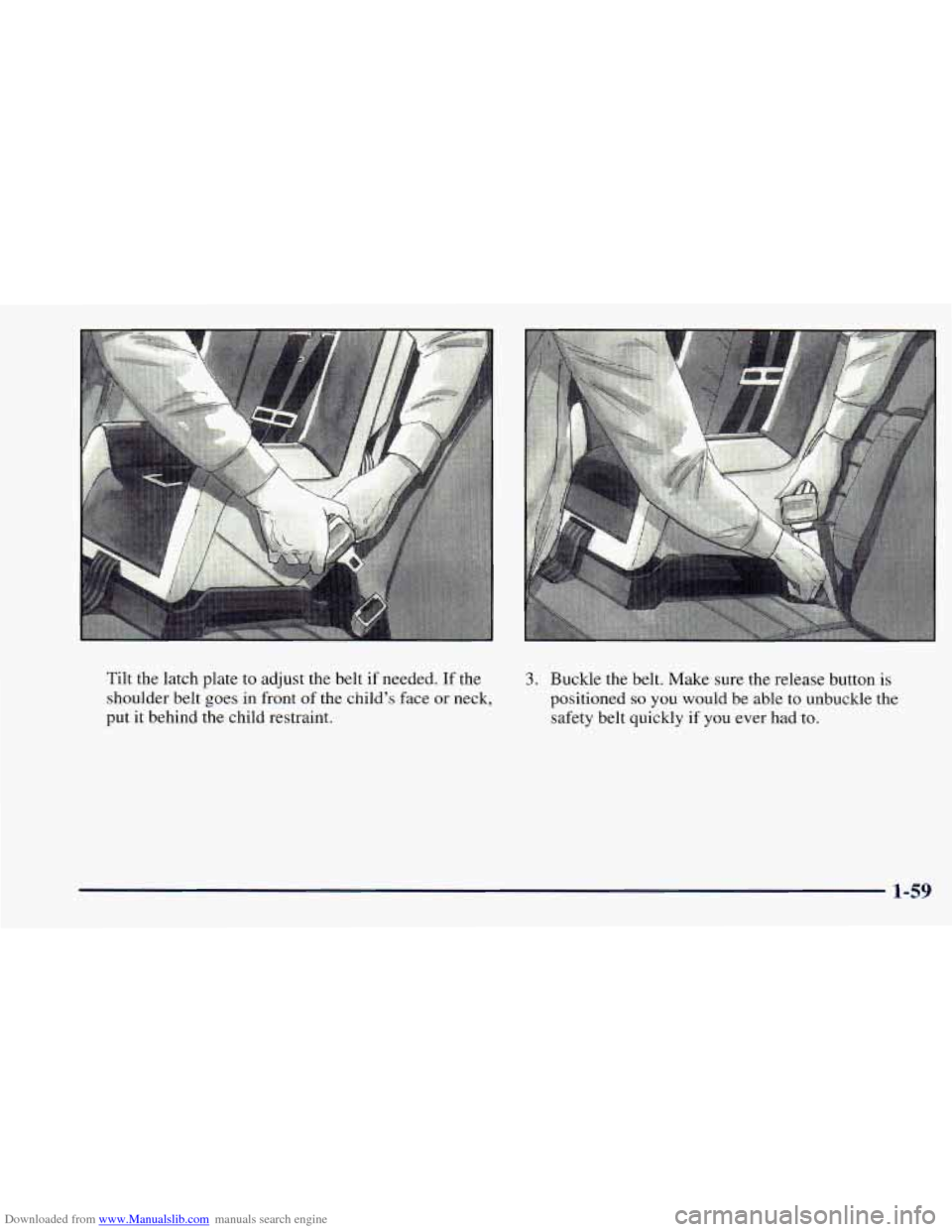
Downloaded from www.Manualslib.com manuals search engine Tilt the latch plate to adjust the belt if needed. If the
shoulder belt goes in front of the child's face or neck,
put
it behind the child restraint.
3. Buckle the belt. Make sure the release button is
positioned so you would be able to unbuckle the
safety belt quickly
if you ever had to.
1-59
Page 74 of 414
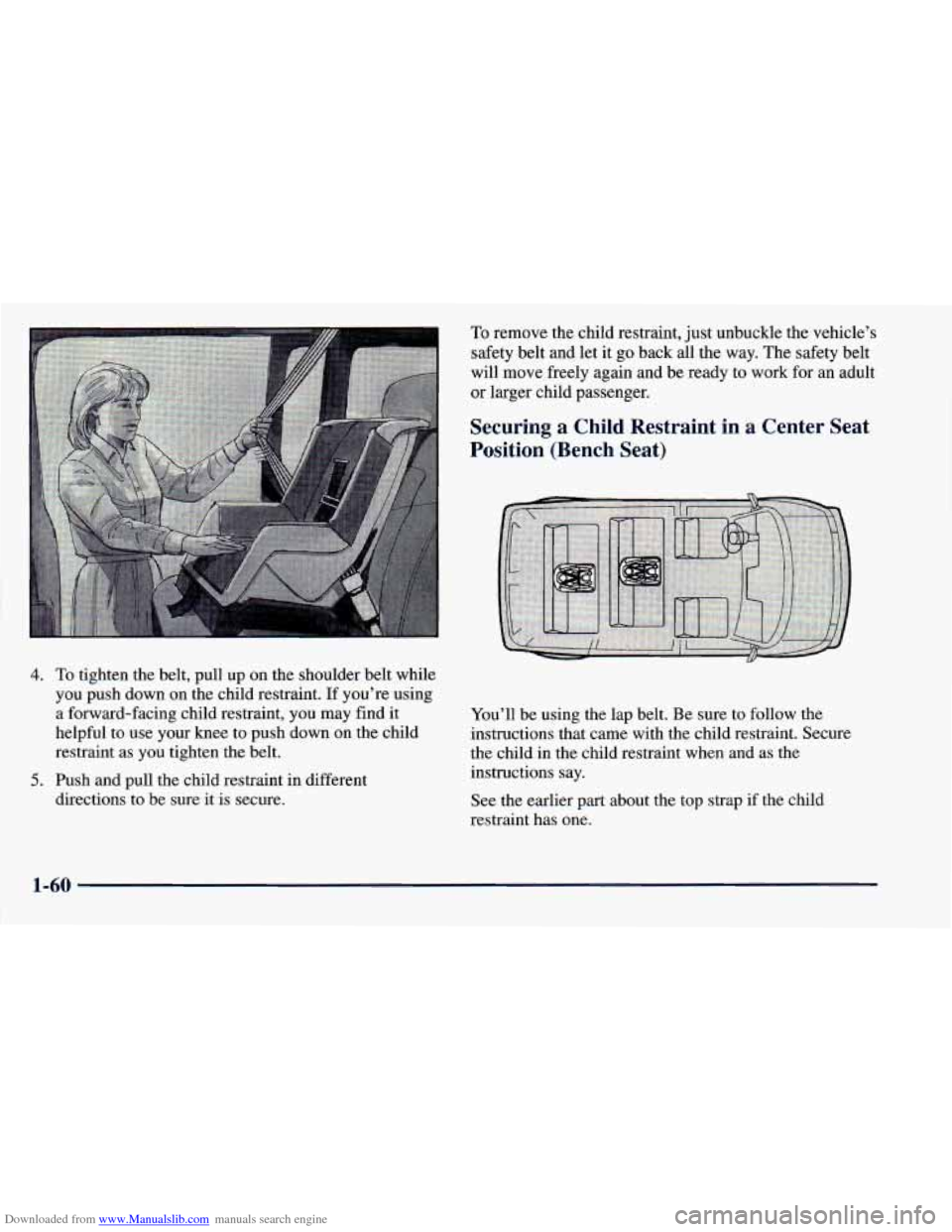
Downloaded from www.Manualslib.com manuals search engine To remove the child restraint, just unbuckle the vehicle’s
safety belt and let it go back all the way. The safety belt
will move freely again and be ready to work for an adult
or larger child passenger.
Securing a Child Restraint in a Center Seat
Position (Bench Seat)
4. To tighten the belt, pull up on the shoulder belt while
you push down on the child restraint. If you’re using
a forward-facing child restraint, you may find it You’ll be using the lap belt. Be sure to follow the
helpful to use your knee to push down on the child instructions that came with the child restraint. Secure
restraint as you tighten the belt. the child in the child restraint when and
as the
directions to be sure
it is secure. See the earlier part about the top strap if the child
5. Push and pull the child restraint in different instructions
say.
restraint has one.
1-60
Page 75 of 414
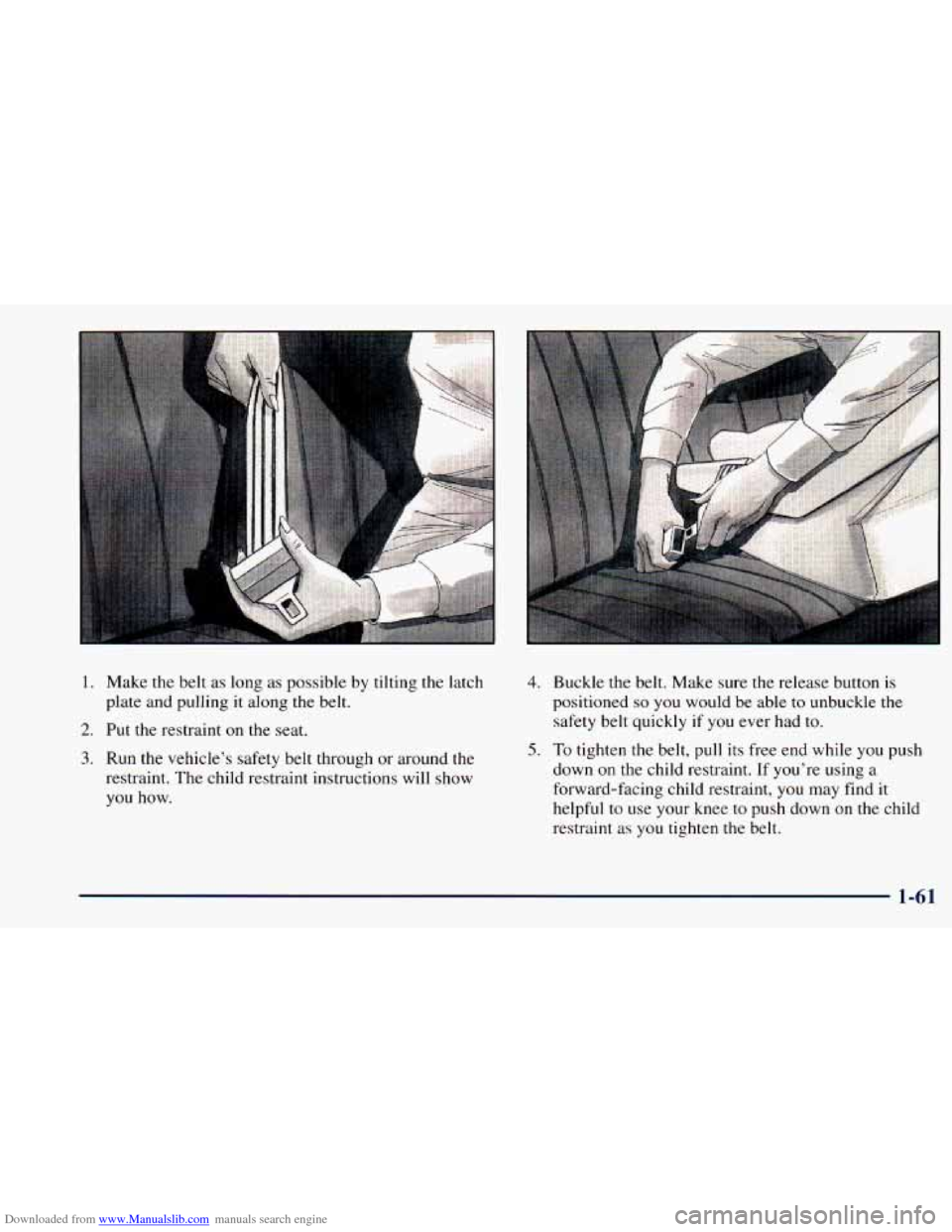
Downloaded from www.Manualslib.com manuals search engine . . . . ., . . .
1.
2.
3.
Make the belt as long as possible by tilting the latch
plate and pulling it along the belt.
Put
the restraint on the seat.
Run the vehicle’s safety belt through or around the
restraint. The child restraint instructions will show
you how.
4. Buckle the belt. Make sure the release button is
positioned
so you would be able to unbuckle the
safety belt quickly if you ever had to.
5. To tighten the belt, pull its free end while you push
down on the child restraint. If you’re using a
forward-facing child restraint, you may find
it
helpful to use your knee to push down on the child
restraint as
you tighten the belt.
1-61
Page 76 of 414
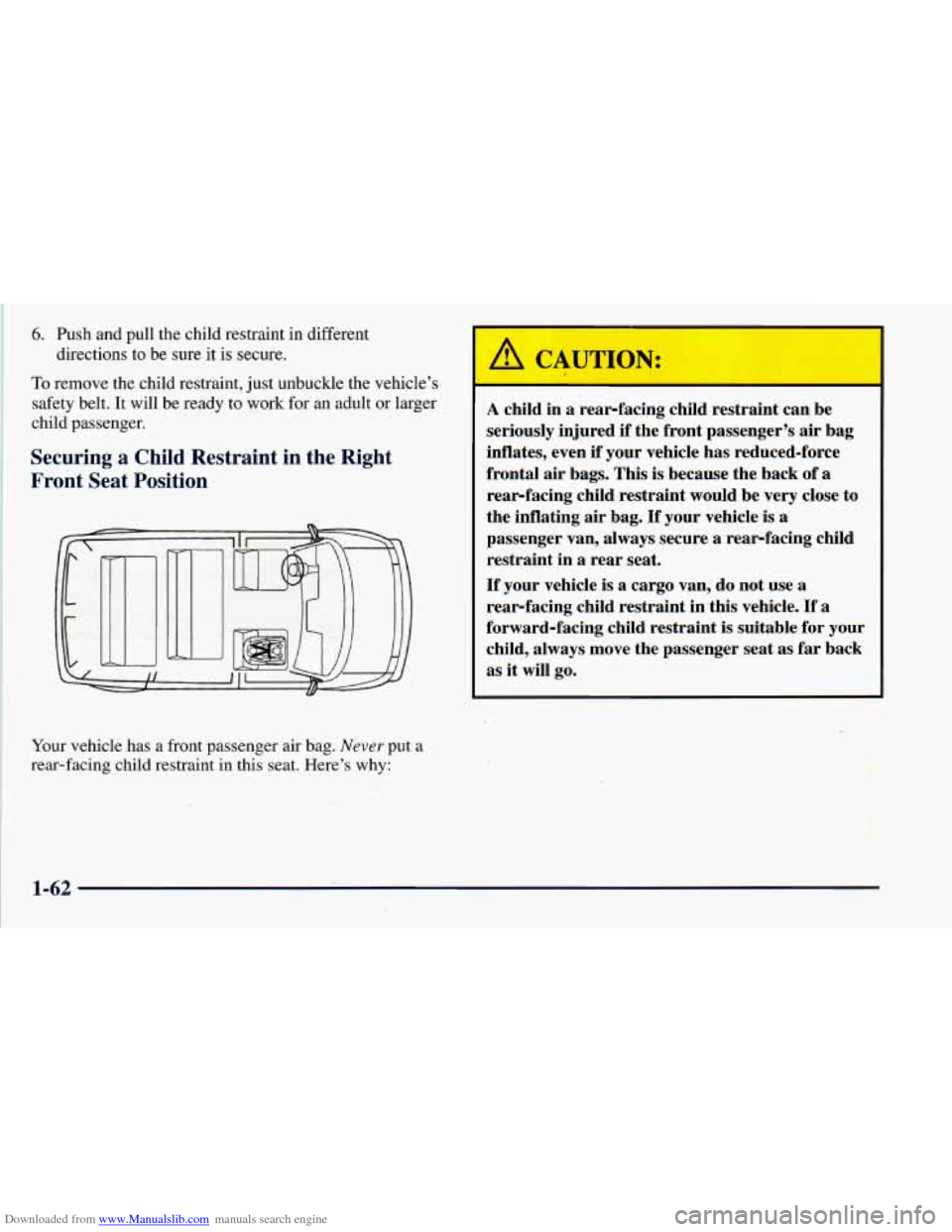
Downloaded from www.Manualslib.com manuals search engine 6. Push and pull the child restraint in different
To remove the child restraint, just unbuckle the vehicle’s
safety belt. It will be ready to work for
an adult or larger
child passenger.
directions to be sure
it
is secure.
Securing a Child Restraint in the Right
Front Seat Position
Your vehicle has a front passenger air bag. Never put a
rear-facing child restraint in this seat. Here’s why:
A CAUTION:
I
A child in a rear-facing child restraint can be
seriously injured if the front passenger’s
air bag
inflates, even
if your vehicle has reduced-force
frontal air bags. This
is because the back of a
rearfacing child restraint would be very close to
the inflating air bag.
If your vehicle is a
passenger van, always secure a rearfacing child
restraint in a rear seat.
If your vehicle is a cargo van, do not use a
rearfacing child restraint in this vehicle. If a
forward-facing child restraint is suitable for your
child, always move the passenger seat as far back
as it will go.
i
1-62
Page 77 of 414
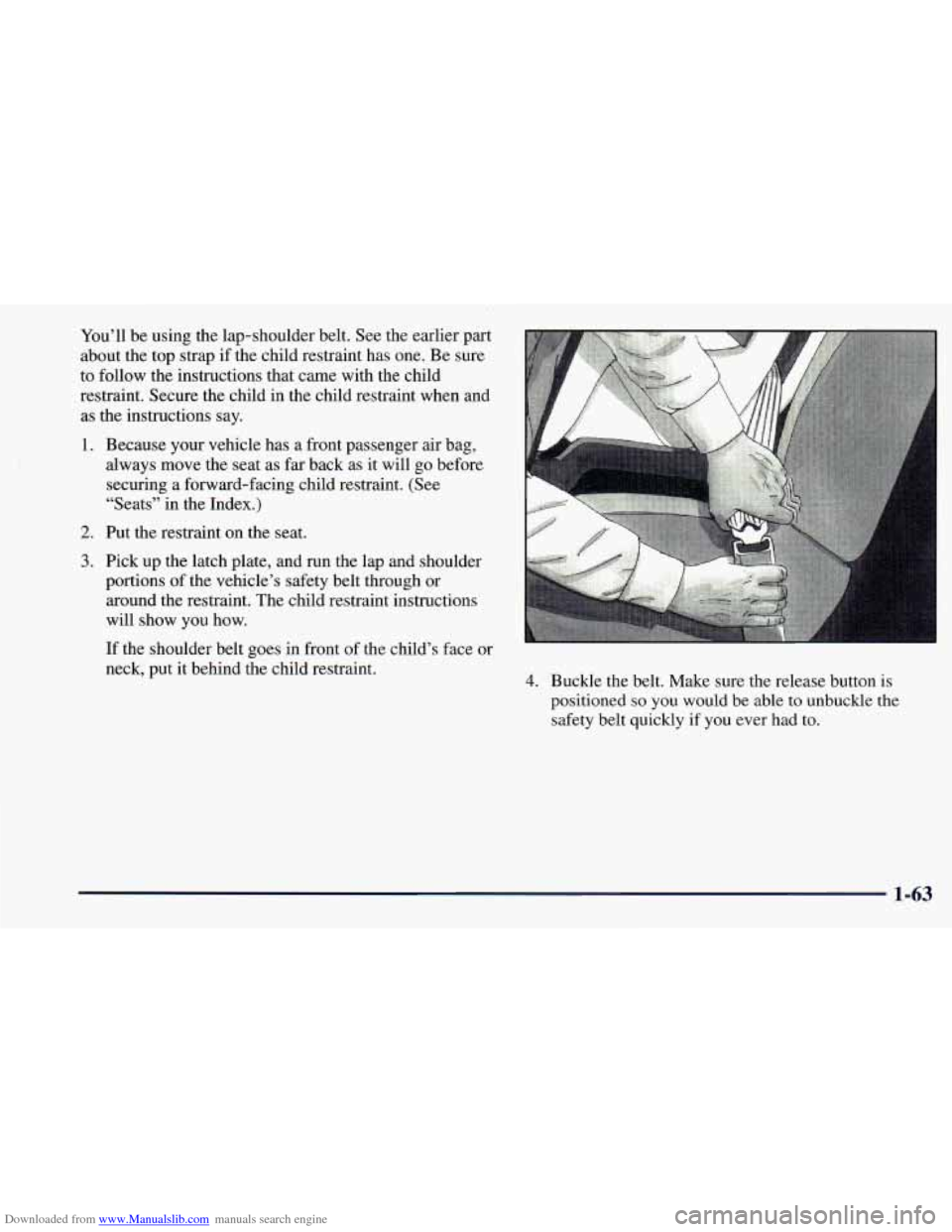
Downloaded from www.Manualslib.com manuals search engine You’ll be using the lap-shoulder belt. See the earlier part
about the top strap if the child restraint has one. Be sure
to follow the instructions that came with the child
restraint. Secure the child in the child restraint when and
as the instructions say.
1. Because your vehicle has a front passenger air bag,
always move the seat as far back as it will
go before
securing a forward-facing child restraint. (See
“Seats” in the Index.)
2. Put the restraint on the seat.
3. Pick up the latch plate, and run the lap and shoulder
portions of the vehicle’s safety belt through or
around the restraint. The child restraint instructions
will show you how.
If the shoulder belt goes in front of the child’s face or
neck, put it behind the child restraint.
4. Buckle the belt. Make sure the release button is
positioned
so you would be able to unbuckle the
safety belt quickly if you ever had to.
1-63
Page 78 of 414
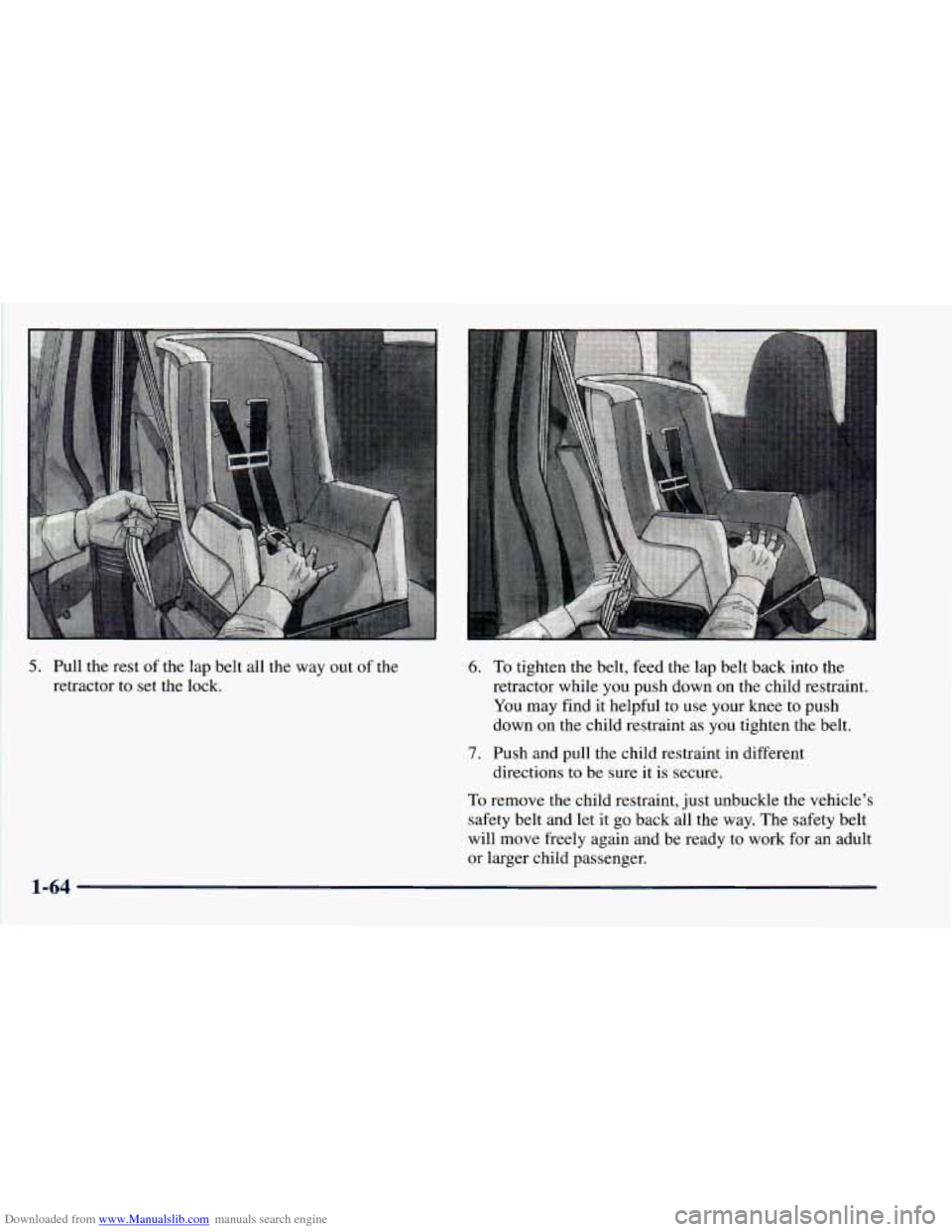
Downloaded from www.Manualslib.com manuals search engine 5. Pull the rest of the lap belt all the way out of the
retractor to set the lock. 6.
7.
To tighten the belt, feed the lap belt back into the
retractor while
you push down on the child restraint.
You may find it helpful to use your knee to push
down on the child restraint as you tighten the belt.
Push and pull the child restraint in different
directions to be sure it is secure.
To remove the child restraint, just unbuckle the vehicle’s
safety belt and let it go back all the way. The safety belt
will move freely again and be ready
to work for an adult
or larger child passenger.
1-64
Page 79 of 414
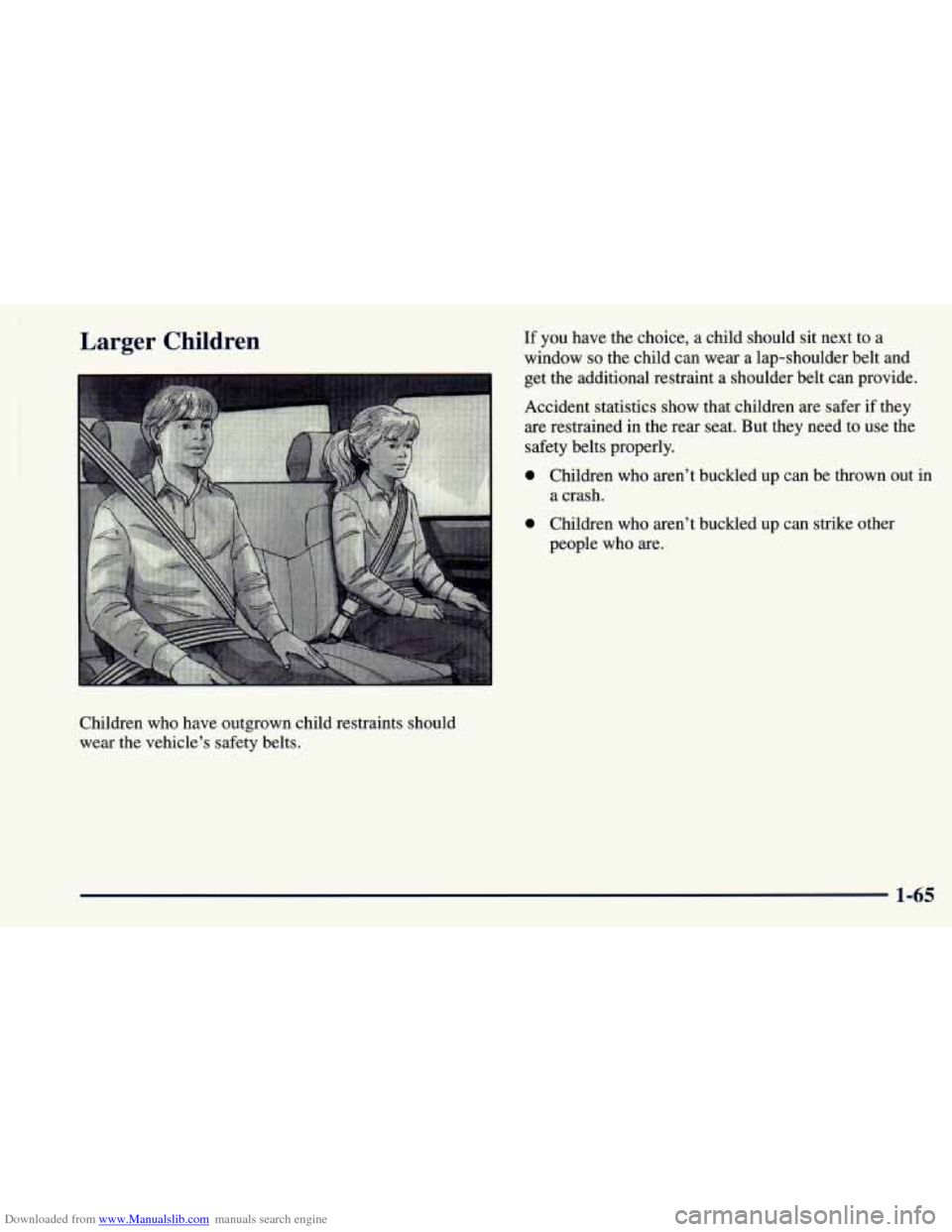
Downloaded from www.Manualslib.com manuals search engine Larger Children
Children who have outgrown child restraints should
wear the vehicle’s safety belts.
If you have the choice, a child should sit next to a
window
so the child can wear a lap-shoulder belt and
get the additional restraint
a shoulder belt can provide.
Accident statistics show that children are safer
if they
are restrained in the rear seat. But they need to use the
safety belts properly.
0 Children who aren’t buckled up can be thrown out in
0 Children who aren’t buckled up can strike other
a
crash.
people who are.
1-65
Page 80 of 414
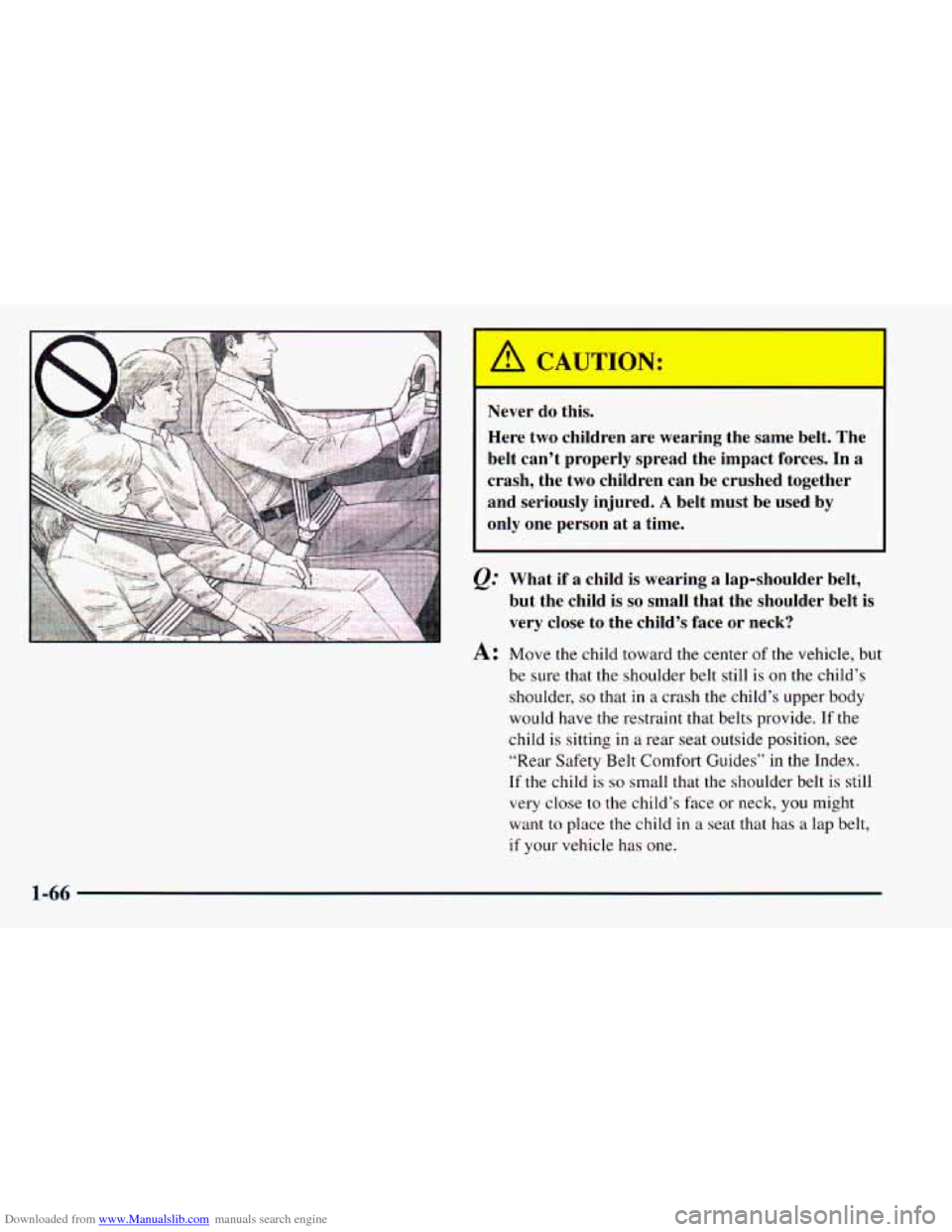
Downloaded from www.Manualslib.com manuals search engine Never do this.
Here two children are wearing the same belt. The
belt can’t properly spread the impact forces.
In a
crash, the two children can be crushed together
and seriously injured.
A belt must be used by
only one person at a time.
Q: What if a child is wearing a lap-shoulder belt,
but the child is
so small that the shoulder belt is
very close to the child’s face or neck?
A: Move the child toward the center of the vehicle, but
be sure that the shoulder belt still is on the child’s
shoulder,
so that in a crash the child’s upper body
would have the restraint that belts provide.
If the
child is sitting
in a rear seat outside position, see
“Rear Safety Belt Comfort Guides” in the Index.
If the child is so small that the shoulder belt is still
very close to the child’s face or neck, you might
want to place the child
in a seat that has a lap belt,
if your vehicle has one.
1-66